Impact of Social Inclusion and Exclusion on Students: Sociology Essay
VerifiedAdded on 2020/07/22
|9
|2631
|61
Essay
AI Summary
This essay delves into the concepts of social inclusion and exclusion within the context of education, specifically examining their impact on students from lower socio-economic backgrounds. The introduction establishes the importance of sociology in understanding societal structures and inequalities, setting the stage for an analysis of how these factors affect students' experiences in school. The essay defines social inclusion as valuing all individuals and ensuring their needs are met, contrasting it with social exclusion, where individuals feel detached and deprived of their rights. The analysis critically examines social inclusion and exclusion in the Australian school system, discussing policies, inclusive pedagogy, and the importance of addressing socio-economic disparities. The essay then defines equity in education, emphasizing fairness and inclusion in opportunity. Furthermore, the discussion explores how schooling can address the needs of students from diverse socio-economic backgrounds, including the impact of early childhood and primary schooling. It also addresses the role of curriculum and pedagogy in fostering an inclusive environment. The conclusion summarizes the direct impact of social inclusion and exclusion on students, highlighting the need for schools to protect students from societal vulnerabilities.
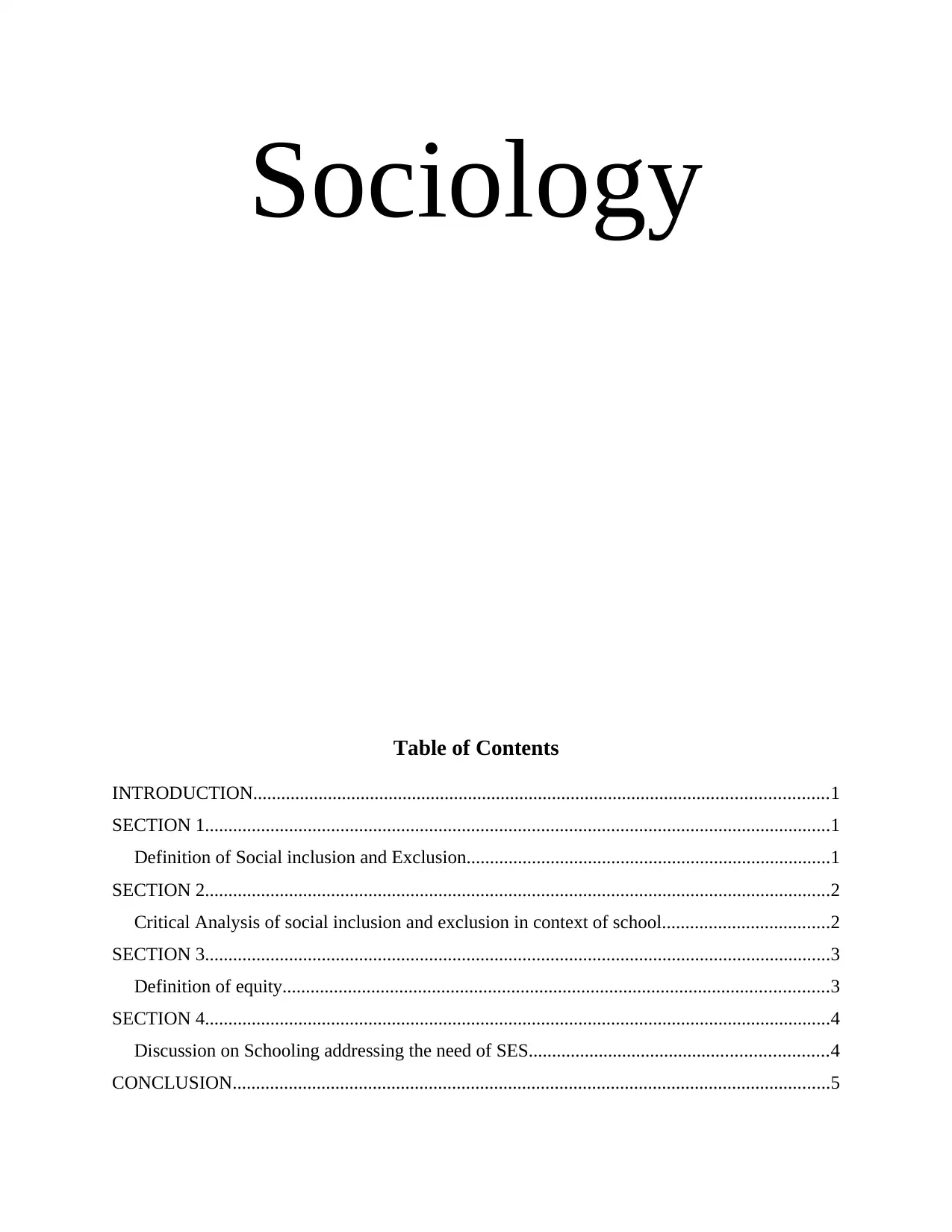
Sociology
Table of Contents
INTRODUCTION...........................................................................................................................1
SECTION 1......................................................................................................................................1
Definition of Social inclusion and Exclusion..............................................................................1
SECTION 2......................................................................................................................................2
Critical Analysis of social inclusion and exclusion in context of school....................................2
SECTION 3......................................................................................................................................3
Definition of equity.....................................................................................................................3
SECTION 4......................................................................................................................................4
Discussion on Schooling addressing the need of SES................................................................4
CONCLUSION................................................................................................................................5
Table of Contents
INTRODUCTION...........................................................................................................................1
SECTION 1......................................................................................................................................1
Definition of Social inclusion and Exclusion..............................................................................1
SECTION 2......................................................................................................................................2
Critical Analysis of social inclusion and exclusion in context of school....................................2
SECTION 3......................................................................................................................................3
Definition of equity.....................................................................................................................3
SECTION 4......................................................................................................................................4
Discussion on Schooling addressing the need of SES................................................................4
CONCLUSION................................................................................................................................5
Paraphrase This Document
Need a fresh take? Get an instant paraphrase of this document with our AI Paraphraser
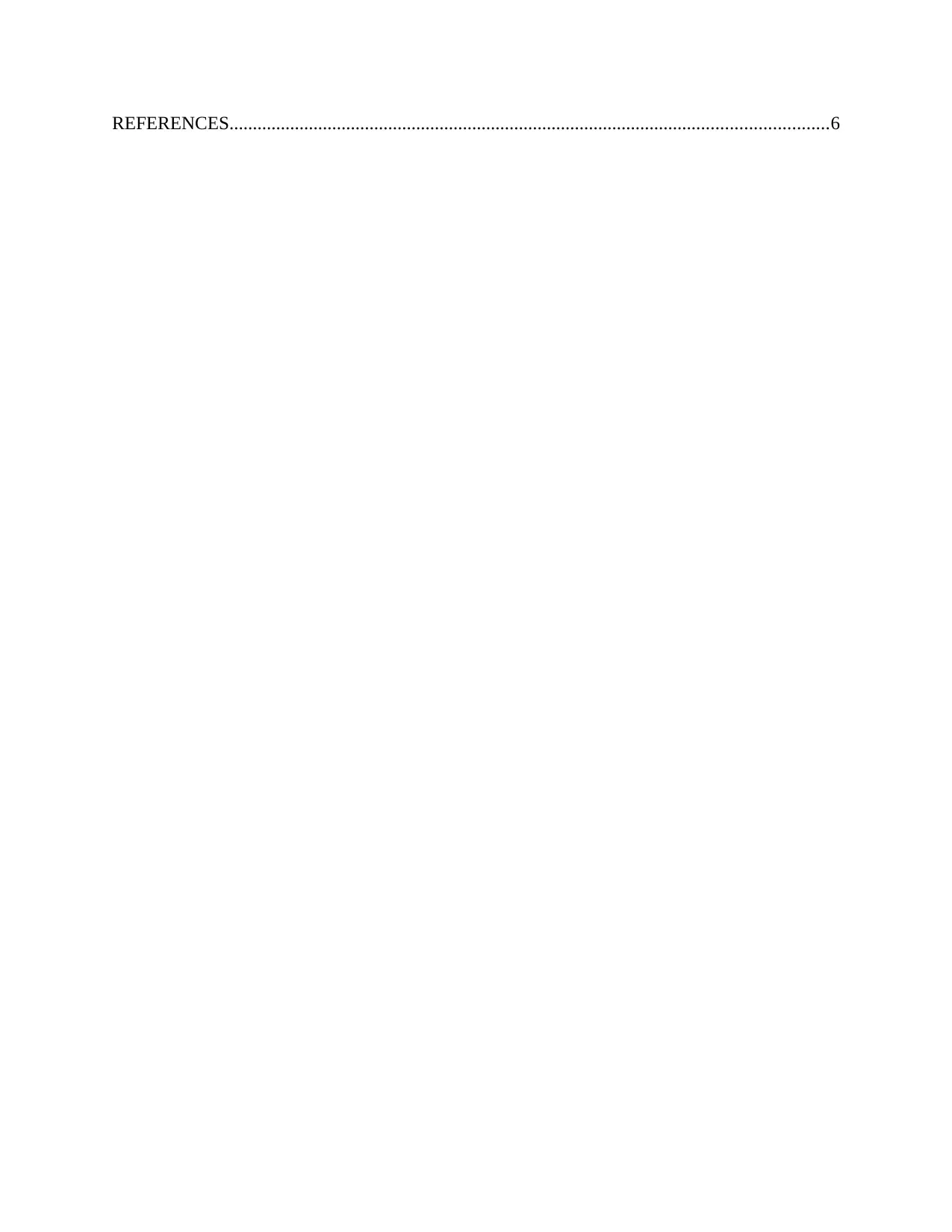
REFERENCES................................................................................................................................6
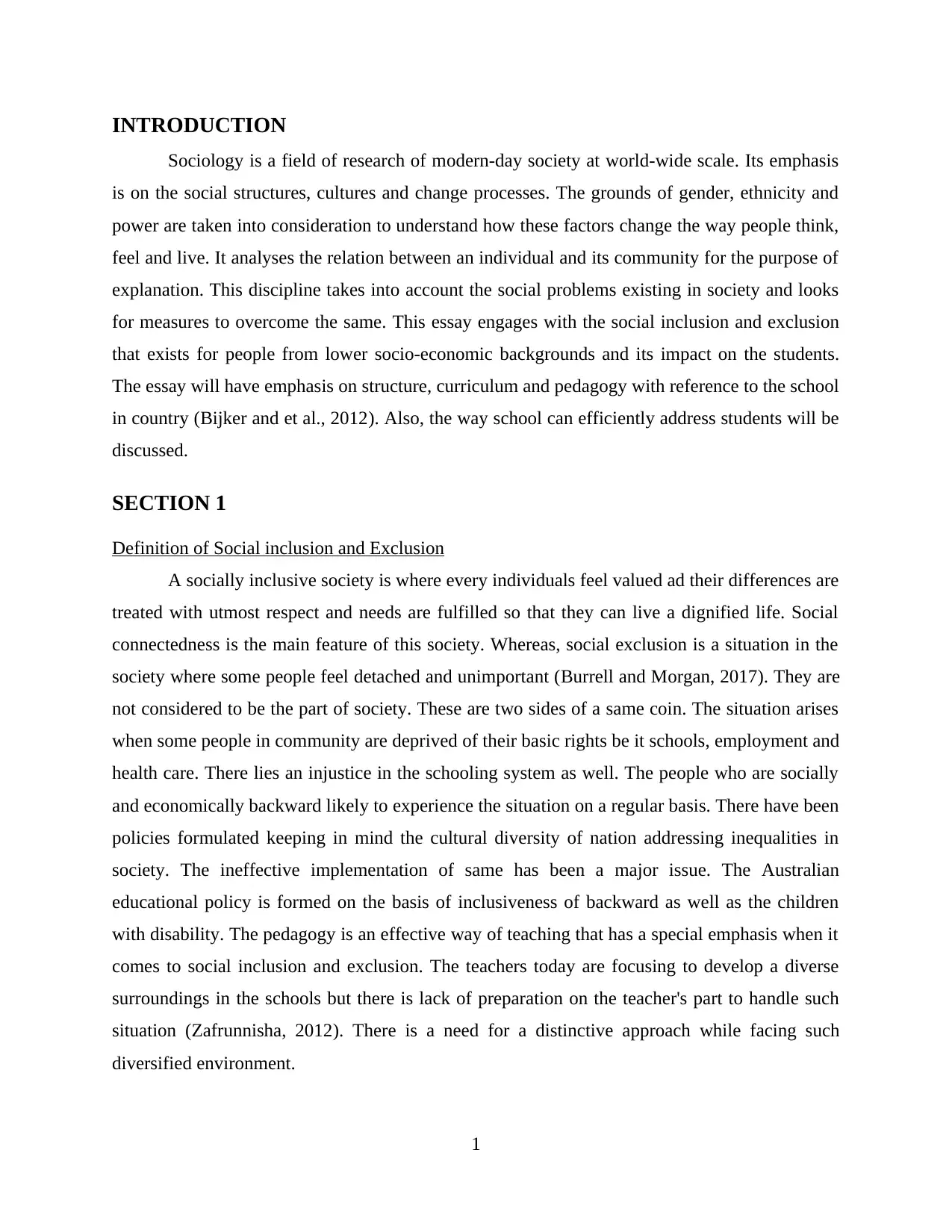
INTRODUCTION
Sociology is a field of research of modern-day society at world-wide scale. Its emphasis
is on the social structures, cultures and change processes. The grounds of gender, ethnicity and
power are taken into consideration to understand how these factors change the way people think,
feel and live. It analyses the relation between an individual and its community for the purpose of
explanation. This discipline takes into account the social problems existing in society and looks
for measures to overcome the same. This essay engages with the social inclusion and exclusion
that exists for people from lower socio-economic backgrounds and its impact on the students.
The essay will have emphasis on structure, curriculum and pedagogy with reference to the school
in country (Bijker and et al., 2012). Also, the way school can efficiently address students will be
discussed.
SECTION 1
Definition of Social inclusion and Exclusion
A socially inclusive society is where every individuals feel valued ad their differences are
treated with utmost respect and needs are fulfilled so that they can live a dignified life. Social
connectedness is the main feature of this society. Whereas, social exclusion is a situation in the
society where some people feel detached and unimportant (Burrell and Morgan, 2017). They are
not considered to be the part of society. These are two sides of a same coin. The situation arises
when some people in community are deprived of their basic rights be it schools, employment and
health care. There lies an injustice in the schooling system as well. The people who are socially
and economically backward likely to experience the situation on a regular basis. There have been
policies formulated keeping in mind the cultural diversity of nation addressing inequalities in
society. The ineffective implementation of same has been a major issue. The Australian
educational policy is formed on the basis of inclusiveness of backward as well as the children
with disability. The pedagogy is an effective way of teaching that has a special emphasis when it
comes to social inclusion and exclusion. The teachers today are focusing to develop a diverse
surroundings in the schools but there is lack of preparation on the teacher's part to handle such
situation (Zafrunnisha, 2012). There is a need for a distinctive approach while facing such
diversified environment.
1
Sociology is a field of research of modern-day society at world-wide scale. Its emphasis
is on the social structures, cultures and change processes. The grounds of gender, ethnicity and
power are taken into consideration to understand how these factors change the way people think,
feel and live. It analyses the relation between an individual and its community for the purpose of
explanation. This discipline takes into account the social problems existing in society and looks
for measures to overcome the same. This essay engages with the social inclusion and exclusion
that exists for people from lower socio-economic backgrounds and its impact on the students.
The essay will have emphasis on structure, curriculum and pedagogy with reference to the school
in country (Bijker and et al., 2012). Also, the way school can efficiently address students will be
discussed.
SECTION 1
Definition of Social inclusion and Exclusion
A socially inclusive society is where every individuals feel valued ad their differences are
treated with utmost respect and needs are fulfilled so that they can live a dignified life. Social
connectedness is the main feature of this society. Whereas, social exclusion is a situation in the
society where some people feel detached and unimportant (Burrell and Morgan, 2017). They are
not considered to be the part of society. These are two sides of a same coin. The situation arises
when some people in community are deprived of their basic rights be it schools, employment and
health care. There lies an injustice in the schooling system as well. The people who are socially
and economically backward likely to experience the situation on a regular basis. There have been
policies formulated keeping in mind the cultural diversity of nation addressing inequalities in
society. The ineffective implementation of same has been a major issue. The Australian
educational policy is formed on the basis of inclusiveness of backward as well as the children
with disability. The pedagogy is an effective way of teaching that has a special emphasis when it
comes to social inclusion and exclusion. The teachers today are focusing to develop a diverse
surroundings in the schools but there is lack of preparation on the teacher's part to handle such
situation (Zafrunnisha, 2012). There is a need for a distinctive approach while facing such
diversified environment.
1
⊘ This is a preview!⊘
Do you want full access?
Subscribe today to unlock all pages.

Trusted by 1+ million students worldwide
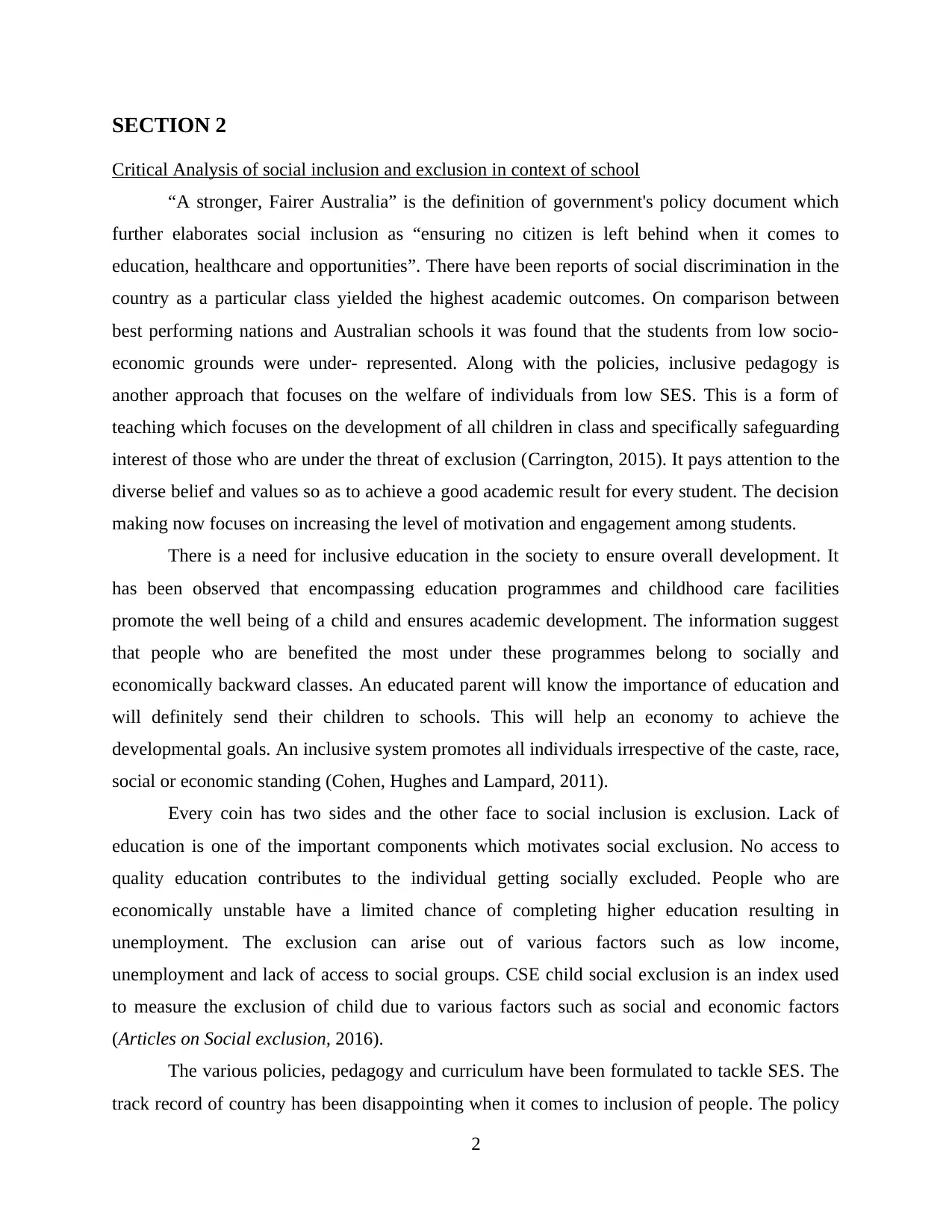
SECTION 2
Critical Analysis of social inclusion and exclusion in context of school
“A stronger, Fairer Australia” is the definition of government's policy document which
further elaborates social inclusion as “ensuring no citizen is left behind when it comes to
education, healthcare and opportunities”. There have been reports of social discrimination in the
country as a particular class yielded the highest academic outcomes. On comparison between
best performing nations and Australian schools it was found that the students from low socio-
economic grounds were under- represented. Along with the policies, inclusive pedagogy is
another approach that focuses on the welfare of individuals from low SES. This is a form of
teaching which focuses on the development of all children in class and specifically safeguarding
interest of those who are under the threat of exclusion (Carrington, 2015). It pays attention to the
diverse belief and values so as to achieve a good academic result for every student. The decision
making now focuses on increasing the level of motivation and engagement among students.
There is a need for inclusive education in the society to ensure overall development. It
has been observed that encompassing education programmes and childhood care facilities
promote the well being of a child and ensures academic development. The information suggest
that people who are benefited the most under these programmes belong to socially and
economically backward classes. An educated parent will know the importance of education and
will definitely send their children to schools. This will help an economy to achieve the
developmental goals. An inclusive system promotes all individuals irrespective of the caste, race,
social or economic standing (Cohen, Hughes and Lampard, 2011).
Every coin has two sides and the other face to social inclusion is exclusion. Lack of
education is one of the important components which motivates social exclusion. No access to
quality education contributes to the individual getting socially excluded. People who are
economically unstable have a limited chance of completing higher education resulting in
unemployment. The exclusion can arise out of various factors such as low income,
unemployment and lack of access to social groups. CSE child social exclusion is an index used
to measure the exclusion of child due to various factors such as social and economic factors
(Articles on Social exclusion, 2016).
The various policies, pedagogy and curriculum have been formulated to tackle SES. The
track record of country has been disappointing when it comes to inclusion of people. The policy
2
Critical Analysis of social inclusion and exclusion in context of school
“A stronger, Fairer Australia” is the definition of government's policy document which
further elaborates social inclusion as “ensuring no citizen is left behind when it comes to
education, healthcare and opportunities”. There have been reports of social discrimination in the
country as a particular class yielded the highest academic outcomes. On comparison between
best performing nations and Australian schools it was found that the students from low socio-
economic grounds were under- represented. Along with the policies, inclusive pedagogy is
another approach that focuses on the welfare of individuals from low SES. This is a form of
teaching which focuses on the development of all children in class and specifically safeguarding
interest of those who are under the threat of exclusion (Carrington, 2015). It pays attention to the
diverse belief and values so as to achieve a good academic result for every student. The decision
making now focuses on increasing the level of motivation and engagement among students.
There is a need for inclusive education in the society to ensure overall development. It
has been observed that encompassing education programmes and childhood care facilities
promote the well being of a child and ensures academic development. The information suggest
that people who are benefited the most under these programmes belong to socially and
economically backward classes. An educated parent will know the importance of education and
will definitely send their children to schools. This will help an economy to achieve the
developmental goals. An inclusive system promotes all individuals irrespective of the caste, race,
social or economic standing (Cohen, Hughes and Lampard, 2011).
Every coin has two sides and the other face to social inclusion is exclusion. Lack of
education is one of the important components which motivates social exclusion. No access to
quality education contributes to the individual getting socially excluded. People who are
economically unstable have a limited chance of completing higher education resulting in
unemployment. The exclusion can arise out of various factors such as low income,
unemployment and lack of access to social groups. CSE child social exclusion is an index used
to measure the exclusion of child due to various factors such as social and economic factors
(Articles on Social exclusion, 2016).
The various policies, pedagogy and curriculum have been formulated to tackle SES. The
track record of country has been disappointing when it comes to inclusion of people. The policy
2
Paraphrase This Document
Need a fresh take? Get an instant paraphrase of this document with our AI Paraphraser
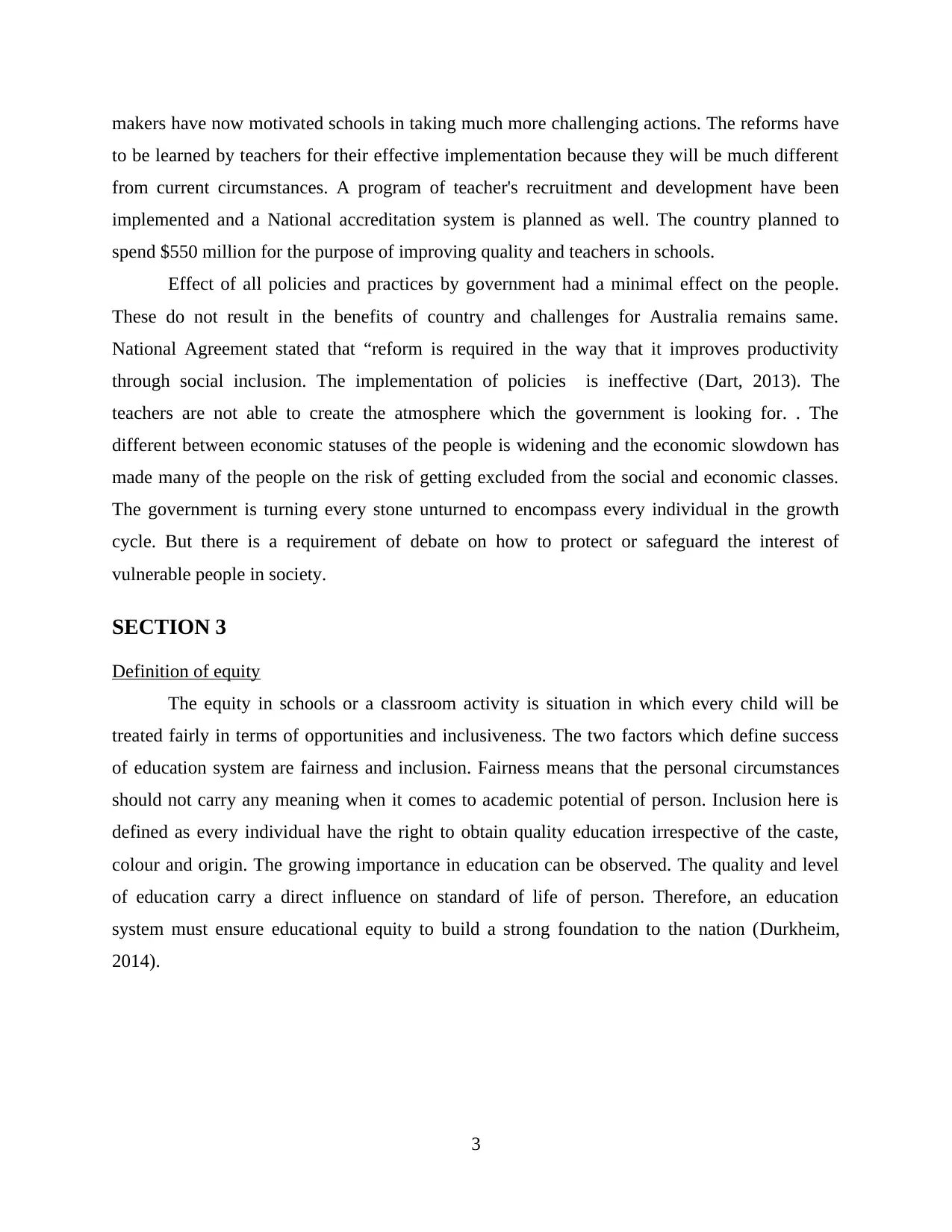
makers have now motivated schools in taking much more challenging actions. The reforms have
to be learned by teachers for their effective implementation because they will be much different
from current circumstances. A program of teacher's recruitment and development have been
implemented and a National accreditation system is planned as well. The country planned to
spend $550 million for the purpose of improving quality and teachers in schools.
Effect of all policies and practices by government had a minimal effect on the people.
These do not result in the benefits of country and challenges for Australia remains same.
National Agreement stated that “reform is required in the way that it improves productivity
through social inclusion. The implementation of policies is ineffective (Dart, 2013). The
teachers are not able to create the atmosphere which the government is looking for. . The
different between economic statuses of the people is widening and the economic slowdown has
made many of the people on the risk of getting excluded from the social and economic classes.
The government is turning every stone unturned to encompass every individual in the growth
cycle. But there is a requirement of debate on how to protect or safeguard the interest of
vulnerable people in society.
SECTION 3
Definition of equity
The equity in schools or a classroom activity is situation in which every child will be
treated fairly in terms of opportunities and inclusiveness. The two factors which define success
of education system are fairness and inclusion. Fairness means that the personal circumstances
should not carry any meaning when it comes to academic potential of person. Inclusion here is
defined as every individual have the right to obtain quality education irrespective of the caste,
colour and origin. The growing importance in education can be observed. The quality and level
of education carry a direct influence on standard of life of person. Therefore, an education
system must ensure educational equity to build a strong foundation to the nation (Durkheim,
2014).
3
to be learned by teachers for their effective implementation because they will be much different
from current circumstances. A program of teacher's recruitment and development have been
implemented and a National accreditation system is planned as well. The country planned to
spend $550 million for the purpose of improving quality and teachers in schools.
Effect of all policies and practices by government had a minimal effect on the people.
These do not result in the benefits of country and challenges for Australia remains same.
National Agreement stated that “reform is required in the way that it improves productivity
through social inclusion. The implementation of policies is ineffective (Dart, 2013). The
teachers are not able to create the atmosphere which the government is looking for. . The
different between economic statuses of the people is widening and the economic slowdown has
made many of the people on the risk of getting excluded from the social and economic classes.
The government is turning every stone unturned to encompass every individual in the growth
cycle. But there is a requirement of debate on how to protect or safeguard the interest of
vulnerable people in society.
SECTION 3
Definition of equity
The equity in schools or a classroom activity is situation in which every child will be
treated fairly in terms of opportunities and inclusiveness. The two factors which define success
of education system are fairness and inclusion. Fairness means that the personal circumstances
should not carry any meaning when it comes to academic potential of person. Inclusion here is
defined as every individual have the right to obtain quality education irrespective of the caste,
colour and origin. The growing importance in education can be observed. The quality and level
of education carry a direct influence on standard of life of person. Therefore, an education
system must ensure educational equity to build a strong foundation to the nation (Durkheim,
2014).
3
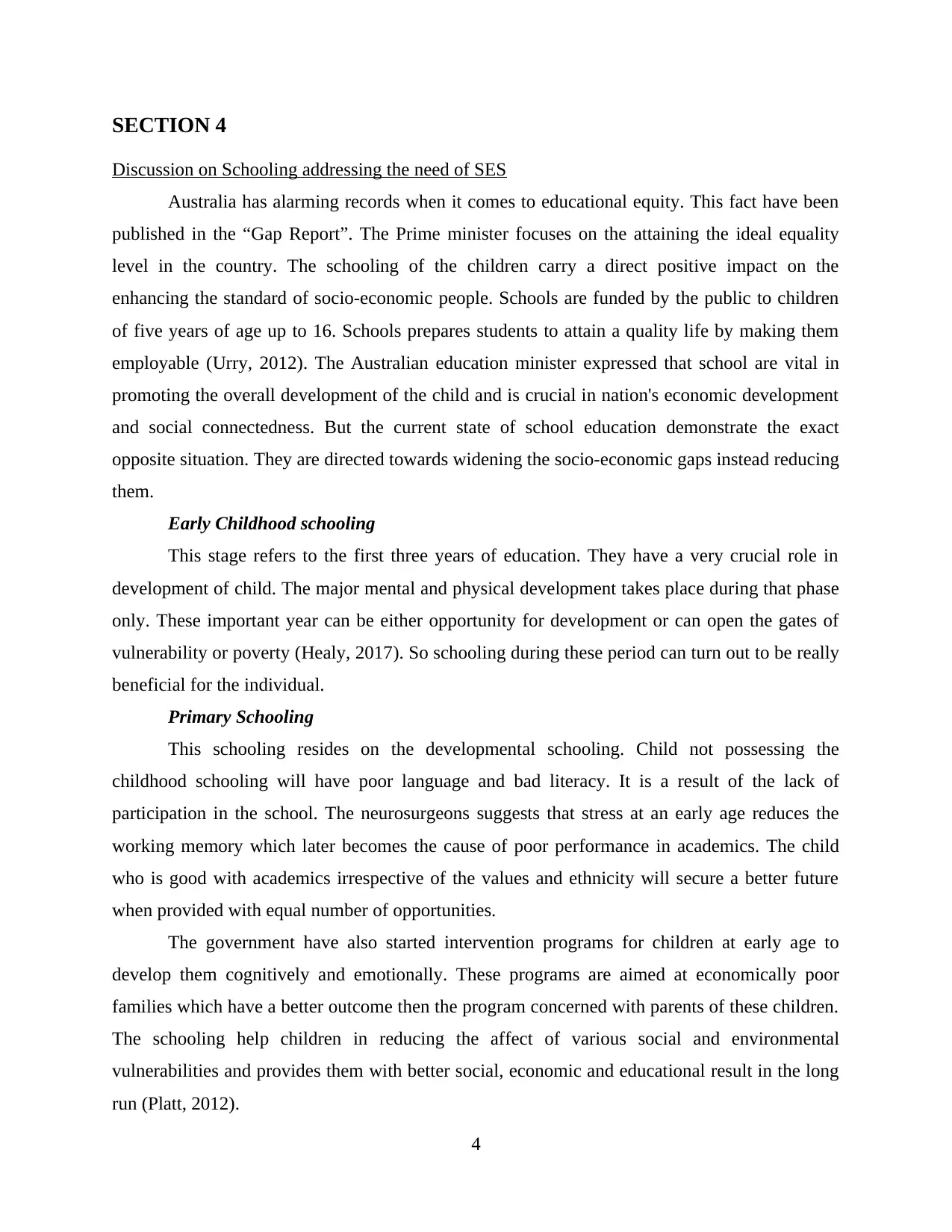
SECTION 4
Discussion on Schooling addressing the need of SES
Australia has alarming records when it comes to educational equity. This fact have been
published in the “Gap Report”. The Prime minister focuses on the attaining the ideal equality
level in the country. The schooling of the children carry a direct positive impact on the
enhancing the standard of socio-economic people. Schools are funded by the public to children
of five years of age up to 16. Schools prepares students to attain a quality life by making them
employable (Urry, 2012). The Australian education minister expressed that school are vital in
promoting the overall development of the child and is crucial in nation's economic development
and social connectedness. But the current state of school education demonstrate the exact
opposite situation. They are directed towards widening the socio-economic gaps instead reducing
them.
Early Childhood schooling
This stage refers to the first three years of education. They have a very crucial role in
development of child. The major mental and physical development takes place during that phase
only. These important year can be either opportunity for development or can open the gates of
vulnerability or poverty (Healy, 2017). So schooling during these period can turn out to be really
beneficial for the individual.
Primary Schooling
This schooling resides on the developmental schooling. Child not possessing the
childhood schooling will have poor language and bad literacy. It is a result of the lack of
participation in the school. The neurosurgeons suggests that stress at an early age reduces the
working memory which later becomes the cause of poor performance in academics. The child
who is good with academics irrespective of the values and ethnicity will secure a better future
when provided with equal number of opportunities.
The government have also started intervention programs for children at early age to
develop them cognitively and emotionally. These programs are aimed at economically poor
families which have a better outcome then the program concerned with parents of these children.
The schooling help children in reducing the affect of various social and environmental
vulnerabilities and provides them with better social, economic and educational result in the long
run (Platt, 2012).
4
Discussion on Schooling addressing the need of SES
Australia has alarming records when it comes to educational equity. This fact have been
published in the “Gap Report”. The Prime minister focuses on the attaining the ideal equality
level in the country. The schooling of the children carry a direct positive impact on the
enhancing the standard of socio-economic people. Schools are funded by the public to children
of five years of age up to 16. Schools prepares students to attain a quality life by making them
employable (Urry, 2012). The Australian education minister expressed that school are vital in
promoting the overall development of the child and is crucial in nation's economic development
and social connectedness. But the current state of school education demonstrate the exact
opposite situation. They are directed towards widening the socio-economic gaps instead reducing
them.
Early Childhood schooling
This stage refers to the first three years of education. They have a very crucial role in
development of child. The major mental and physical development takes place during that phase
only. These important year can be either opportunity for development or can open the gates of
vulnerability or poverty (Healy, 2017). So schooling during these period can turn out to be really
beneficial for the individual.
Primary Schooling
This schooling resides on the developmental schooling. Child not possessing the
childhood schooling will have poor language and bad literacy. It is a result of the lack of
participation in the school. The neurosurgeons suggests that stress at an early age reduces the
working memory which later becomes the cause of poor performance in academics. The child
who is good with academics irrespective of the values and ethnicity will secure a better future
when provided with equal number of opportunities.
The government have also started intervention programs for children at early age to
develop them cognitively and emotionally. These programs are aimed at economically poor
families which have a better outcome then the program concerned with parents of these children.
The schooling help children in reducing the affect of various social and environmental
vulnerabilities and provides them with better social, economic and educational result in the long
run (Platt, 2012).
4
⊘ This is a preview!⊘
Do you want full access?
Subscribe today to unlock all pages.

Trusted by 1+ million students worldwide
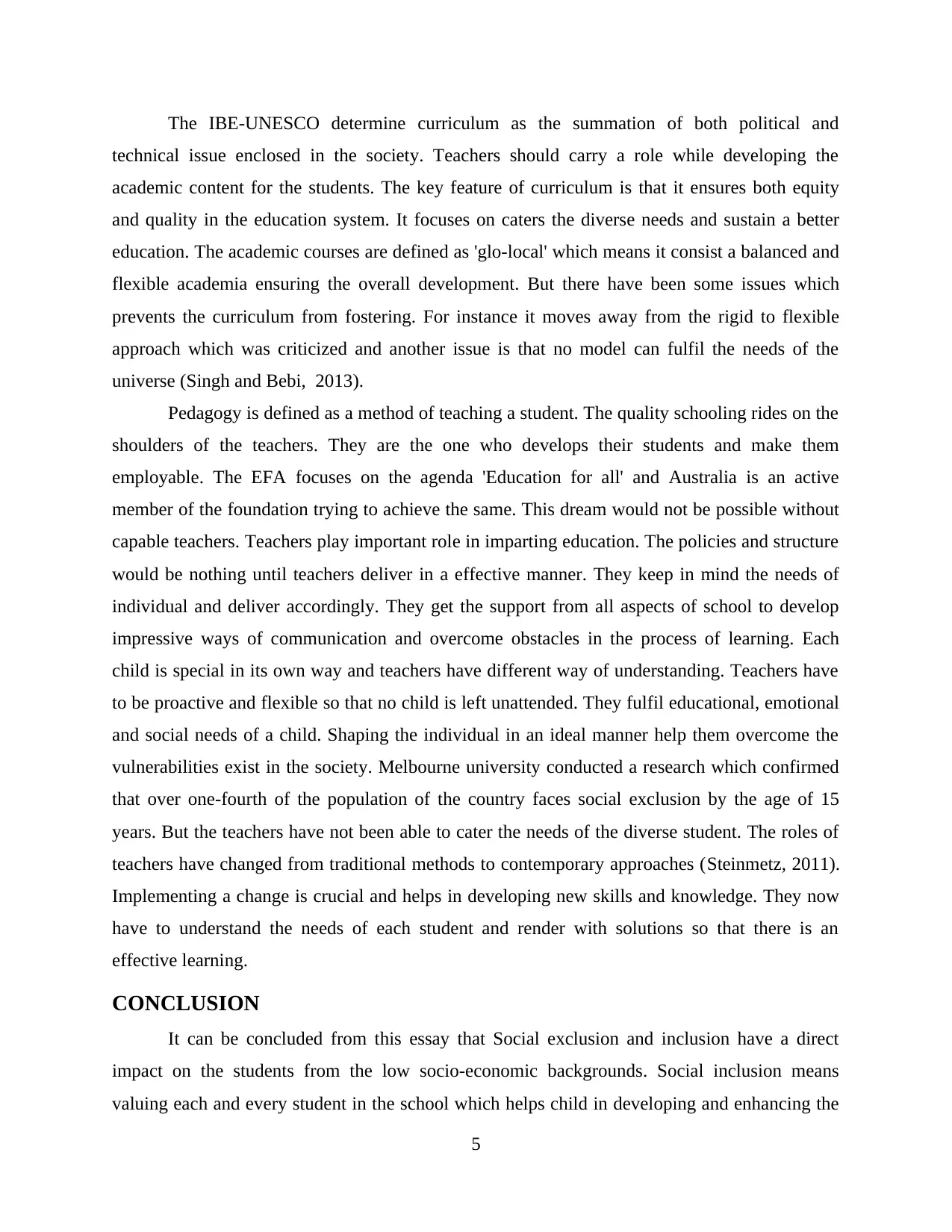
The IBE-UNESCO determine curriculum as the summation of both political and
technical issue enclosed in the society. Teachers should carry a role while developing the
academic content for the students. The key feature of curriculum is that it ensures both equity
and quality in the education system. It focuses on caters the diverse needs and sustain a better
education. The academic courses are defined as 'glo-local' which means it consist a balanced and
flexible academia ensuring the overall development. But there have been some issues which
prevents the curriculum from fostering. For instance it moves away from the rigid to flexible
approach which was criticized and another issue is that no model can fulfil the needs of the
universe (Singh and Bebi, 2013).
Pedagogy is defined as a method of teaching a student. The quality schooling rides on the
shoulders of the teachers. They are the one who develops their students and make them
employable. The EFA focuses on the agenda 'Education for all' and Australia is an active
member of the foundation trying to achieve the same. This dream would not be possible without
capable teachers. Teachers play important role in imparting education. The policies and structure
would be nothing until teachers deliver in a effective manner. They keep in mind the needs of
individual and deliver accordingly. They get the support from all aspects of school to develop
impressive ways of communication and overcome obstacles in the process of learning. Each
child is special in its own way and teachers have different way of understanding. Teachers have
to be proactive and flexible so that no child is left unattended. They fulfil educational, emotional
and social needs of a child. Shaping the individual in an ideal manner help them overcome the
vulnerabilities exist in the society. Melbourne university conducted a research which confirmed
that over one-fourth of the population of the country faces social exclusion by the age of 15
years. But the teachers have not been able to cater the needs of the diverse student. The roles of
teachers have changed from traditional methods to contemporary approaches (Steinmetz, 2011).
Implementing a change is crucial and helps in developing new skills and knowledge. They now
have to understand the needs of each student and render with solutions so that there is an
effective learning.
CONCLUSION
It can be concluded from this essay that Social exclusion and inclusion have a direct
impact on the students from the low socio-economic backgrounds. Social inclusion means
valuing each and every student in the school which helps child in developing and enhancing the
5
technical issue enclosed in the society. Teachers should carry a role while developing the
academic content for the students. The key feature of curriculum is that it ensures both equity
and quality in the education system. It focuses on caters the diverse needs and sustain a better
education. The academic courses are defined as 'glo-local' which means it consist a balanced and
flexible academia ensuring the overall development. But there have been some issues which
prevents the curriculum from fostering. For instance it moves away from the rigid to flexible
approach which was criticized and another issue is that no model can fulfil the needs of the
universe (Singh and Bebi, 2013).
Pedagogy is defined as a method of teaching a student. The quality schooling rides on the
shoulders of the teachers. They are the one who develops their students and make them
employable. The EFA focuses on the agenda 'Education for all' and Australia is an active
member of the foundation trying to achieve the same. This dream would not be possible without
capable teachers. Teachers play important role in imparting education. The policies and structure
would be nothing until teachers deliver in a effective manner. They keep in mind the needs of
individual and deliver accordingly. They get the support from all aspects of school to develop
impressive ways of communication and overcome obstacles in the process of learning. Each
child is special in its own way and teachers have different way of understanding. Teachers have
to be proactive and flexible so that no child is left unattended. They fulfil educational, emotional
and social needs of a child. Shaping the individual in an ideal manner help them overcome the
vulnerabilities exist in the society. Melbourne university conducted a research which confirmed
that over one-fourth of the population of the country faces social exclusion by the age of 15
years. But the teachers have not been able to cater the needs of the diverse student. The roles of
teachers have changed from traditional methods to contemporary approaches (Steinmetz, 2011).
Implementing a change is crucial and helps in developing new skills and knowledge. They now
have to understand the needs of each student and render with solutions so that there is an
effective learning.
CONCLUSION
It can be concluded from this essay that Social exclusion and inclusion have a direct
impact on the students from the low socio-economic backgrounds. Social inclusion means
valuing each and every student in the school which helps child in developing and enhancing the
5
Paraphrase This Document
Need a fresh take? Get an instant paraphrase of this document with our AI Paraphraser
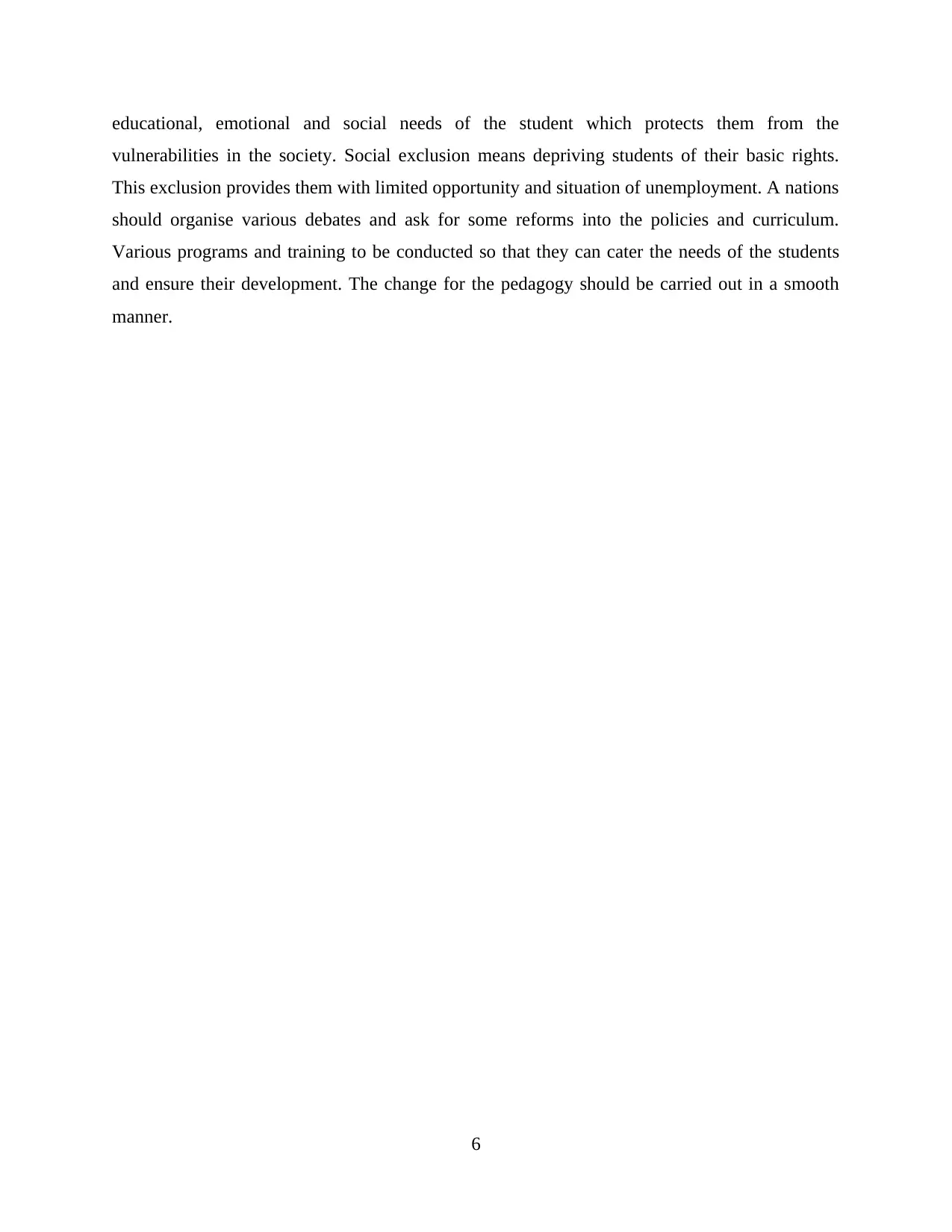
educational, emotional and social needs of the student which protects them from the
vulnerabilities in the society. Social exclusion means depriving students of their basic rights.
This exclusion provides them with limited opportunity and situation of unemployment. A nations
should organise various debates and ask for some reforms into the policies and curriculum.
Various programs and training to be conducted so that they can cater the needs of the students
and ensure their development. The change for the pedagogy should be carried out in a smooth
manner.
6
vulnerabilities in the society. Social exclusion means depriving students of their basic rights.
This exclusion provides them with limited opportunity and situation of unemployment. A nations
should organise various debates and ask for some reforms into the policies and curriculum.
Various programs and training to be conducted so that they can cater the needs of the students
and ensure their development. The change for the pedagogy should be carried out in a smooth
manner.
6
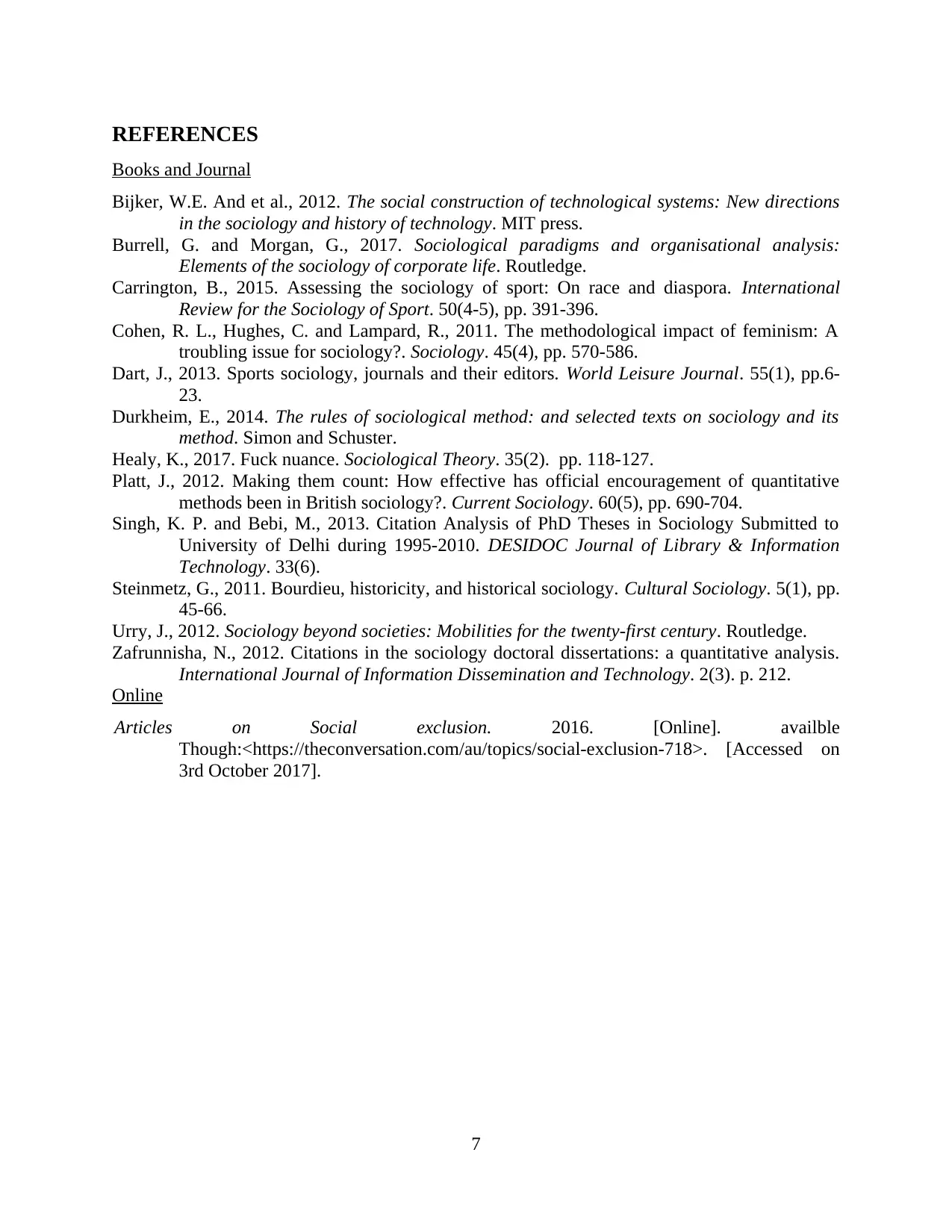
REFERENCES
Books and Journal
Bijker, W.E. And et al., 2012. The social construction of technological systems: New directions
in the sociology and history of technology. MIT press.
Burrell, G. and Morgan, G., 2017. Sociological paradigms and organisational analysis:
Elements of the sociology of corporate life. Routledge.
Carrington, B., 2015. Assessing the sociology of sport: On race and diaspora. International
Review for the Sociology of Sport. 50(4-5), pp. 391-396.
Cohen, R. L., Hughes, C. and Lampard, R., 2011. The methodological impact of feminism: A
troubling issue for sociology?. Sociology. 45(4), pp. 570-586.
Dart, J., 2013. Sports sociology, journals and their editors. World Leisure Journal. 55(1), pp.6-
23.
Durkheim, E., 2014. The rules of sociological method: and selected texts on sociology and its
method. Simon and Schuster.
Healy, K., 2017. Fuck nuance. Sociological Theory. 35(2). pp. 118-127.
Platt, J., 2012. Making them count: How effective has official encouragement of quantitative
methods been in British sociology?. Current Sociology. 60(5), pp. 690-704.
Singh, K. P. and Bebi, M., 2013. Citation Analysis of PhD Theses in Sociology Submitted to
University of Delhi during 1995-2010. DESIDOC Journal of Library & Information
Technology. 33(6).
Steinmetz, G., 2011. Bourdieu, historicity, and historical sociology. Cultural Sociology. 5(1), pp.
45-66.
Urry, J., 2012. Sociology beyond societies: Mobilities for the twenty-first century. Routledge.
Zafrunnisha, N., 2012. Citations in the sociology doctoral dissertations: a quantitative analysis.
International Journal of Information Dissemination and Technology. 2(3). p. 212.
Online
Articles on Social exclusion. 2016. [Online]. availble
Though:<https://theconversation.com/au/topics/social-exclusion-718>. [Accessed on
3rd October 2017].
7
Books and Journal
Bijker, W.E. And et al., 2012. The social construction of technological systems: New directions
in the sociology and history of technology. MIT press.
Burrell, G. and Morgan, G., 2017. Sociological paradigms and organisational analysis:
Elements of the sociology of corporate life. Routledge.
Carrington, B., 2015. Assessing the sociology of sport: On race and diaspora. International
Review for the Sociology of Sport. 50(4-5), pp. 391-396.
Cohen, R. L., Hughes, C. and Lampard, R., 2011. The methodological impact of feminism: A
troubling issue for sociology?. Sociology. 45(4), pp. 570-586.
Dart, J., 2013. Sports sociology, journals and their editors. World Leisure Journal. 55(1), pp.6-
23.
Durkheim, E., 2014. The rules of sociological method: and selected texts on sociology and its
method. Simon and Schuster.
Healy, K., 2017. Fuck nuance. Sociological Theory. 35(2). pp. 118-127.
Platt, J., 2012. Making them count: How effective has official encouragement of quantitative
methods been in British sociology?. Current Sociology. 60(5), pp. 690-704.
Singh, K. P. and Bebi, M., 2013. Citation Analysis of PhD Theses in Sociology Submitted to
University of Delhi during 1995-2010. DESIDOC Journal of Library & Information
Technology. 33(6).
Steinmetz, G., 2011. Bourdieu, historicity, and historical sociology. Cultural Sociology. 5(1), pp.
45-66.
Urry, J., 2012. Sociology beyond societies: Mobilities for the twenty-first century. Routledge.
Zafrunnisha, N., 2012. Citations in the sociology doctoral dissertations: a quantitative analysis.
International Journal of Information Dissemination and Technology. 2(3). p. 212.
Online
Articles on Social exclusion. 2016. [Online]. availble
Though:<https://theconversation.com/au/topics/social-exclusion-718>. [Accessed on
3rd October 2017].
7
⊘ This is a preview!⊘
Do you want full access?
Subscribe today to unlock all pages.

Trusted by 1+ million students worldwide
1 out of 9
Related Documents
Your All-in-One AI-Powered Toolkit for Academic Success.
+13062052269
info@desklib.com
Available 24*7 on WhatsApp / Email
![[object Object]](/_next/static/media/star-bottom.7253800d.svg)
Unlock your academic potential
Copyright © 2020–2025 A2Z Services. All Rights Reserved. Developed and managed by ZUCOL.





